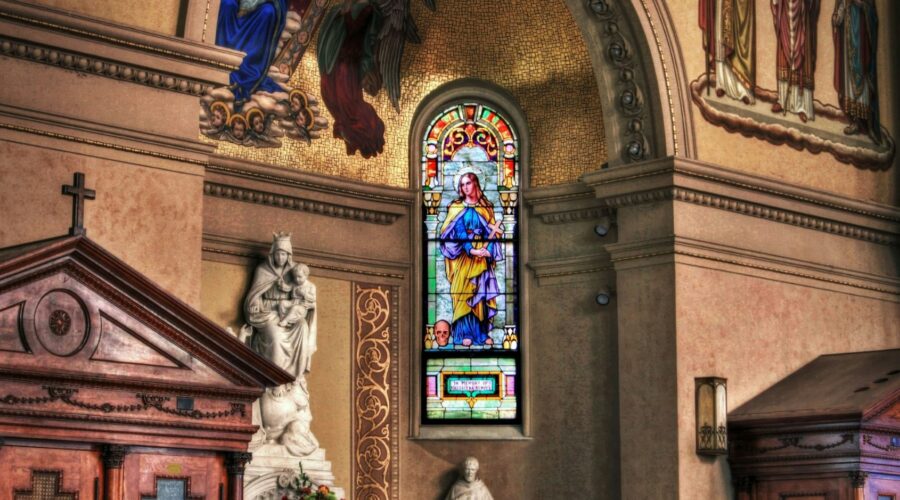Your cart is currently empty!
Assumption Church: A Guide to History, Architecture, and Significance

Introduction
Assumption Church, also known as the Church of the Assumption of the Blessed Virgin Mary, stands as an architectural and historical marvel in several cities around the world. This stunning edifice has captivated hearts and minds for centuries, holding a profound significance for religious communities and art enthusiasts alike.
In this comprehensive guide, we embark on a journey to uncover the rich tapestry of Assumption Church’s history, architectural wonders, and religious importance.
History
Early Origins
The origins of Assumption Church can be traced back to the 4th century, when Emperor Constantine the Great converted to Christianity and commissioned the construction of churches throughout the Roman Empire.
One of the earliest known Assumption churches was built in Jerusalem on the site believed to be where Mary, the mother of Jesus, ascended to heaven. This church was destroyed in 614 AD by the Persian invasion.
Medieval Era
During the medieval period, Assumption churches were built across Europe, often as part of monasteries or cathedrals. These churches typically featured Romanesque or Gothic architectural styles and were adorned with elaborate carvings and stained glass windows.
One of the most famous Assumption churches from this era is the Assumption Cathedral in Moscow, Russia. This magnificent edifice was built in the 15th century and served as the coronation church for Russian tsars.
Renaissance and Baroque Eras
During the Renaissance and Baroque eras, Assumption churches continued to be built and expanded throughout Europe. These churches embraced the architectural styles of the time, incorporating elements such as domes, cupolas, and intricate facades.
Notable examples from this period include the Assumption Cathedral in Venice, Italy, and the Church of the Assumption in Valletta, Malta.
Architecture
Distinctive Features
Assumption churches are characterized by several distinctive architectural features that set them apart from other religious buildings.
- Symbolic Dome: Many Assumption churches feature a central dome, symbolizing the heavenly realm where Mary ascended.
- Elaborate Facades: The facades of Assumption churches are often adorned with intricate carvings, sculptures, and paintings depicting scenes from Mary’s life.
- Stained Glass Windows: Stained glass windows in Assumption churches frequently depict the Assumption of Mary into heaven.
Architectural Styles
Assumption churches have been built in a wide range of architectural styles over the centuries, including:
- Romanesque: Thick walls, rounded arches, and small windows
- Gothic: Pointed arches, ribbed vaults, and large stained glass windows
- Renaissance: Classical proportions, domes, and elaborate ornamentation
- Baroque: Ornate facades, curved lines, and opulent interiors
Religious Significance
Assumption Church holds great religious significance for Christians, particularly for Catholics and Orthodox Christians. The Assumption of Mary is a central belief in Christian tradition, referring to the belief that Mary was taken up into heaven both body and soul at the end of her earthly life.
Assumption churches are often used for:
- Masses and Services: Regular religious services are held in Assumption churches, particularly on the feast of the Assumption (August 15th).
- Pilgrimage Sites: Some Assumption churches are renowned pilgrimage sites, attracting visitors seeking spiritual renewal and connection with Mary.
- Devotional Practices: Assumption churches are often places where people pray, light candles, and offer other devotions to Mary.
List of Notable Assumption Churches
Here is a non-exhaustive list of notable Assumption churches around the world:
- Assumption Cathedral, Moscow, Russia
- Assumption Cathedral, Vladimir, Russia
- Assumption Cathedral, Verona, Italy
- Assumption Cathedral, Venice, Italy
- Church of the Assumption, Valletta, Malta
- Assumption Cathedral, Denver, United States
- Assumption Cathedral, San Antonio, United States
- Assumption Church, Chicago, United States
Conclusion
Assumption Church is a testament to the enduring faith and artistic expression of Christian communities throughout history. Its stunning architecture, rich symbolism, and religious significance make it a beloved destination for pilgrims, art enthusiasts, and believers alike.
From the early origins in Jerusalem to the magnificent edifices that grace cities around the world, Assumption Church continues to inspire awe and devotion, serving as a timeless reminder of the enduring presence of the divine in our lives.